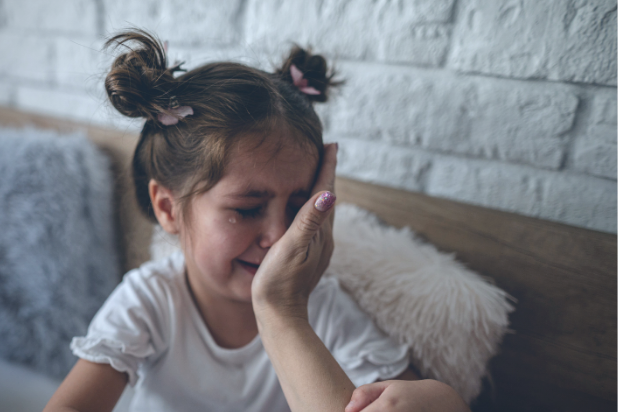
The first time my daughter experienced a sleep terror, I was terrified.
Our typically happy preschooler was crying out, hands shaking and eyes wide open. I tried to comfort her, but she continued frantically searching for me — even though I was standing in front of her. I didn’t know that she couldn’t see me because she was actually still asleep.
Whether it’s anxious slumber, nightmares or a full-fledged terror, sleep disturbances are unsettling for children and caregivers. Fortunately, parents can learn strategies to help their little ones get back to sleep and prevent the scaries from returning.
Bad Dreams: What Causes Them
Nightmares — a common and normal part of development — are a psychological response to a child’s insecurities and fears. They are most common in school-age children but also occur in preschoolers and adolescents.
Dr. Melody Hawkins of the Pediatric and Adolescent Sleep Center in Fairfax, Virginia, says that the type of nightmares kids experience depends on their age.
“Usually in younger kids, frequently the concern is that they’ve been separated from their parent,” says Hawkins. Older kids often have nightmares that something might happen to them, such as instances where they might experience harm or embarrassment.
Dr. Maria Veronica Bautista, head of the division of pediatric pulmonary and sleep medicine at MedStar Georgetown University Hospital in Washington, D.C., adds that bad dreams in smaller children typically happen within a day or two of a frightening event.
Common causes of bad dreams include scary movies, fears, traumatic events and big life or schedule changes. Situations such as being bullied can also cause nightmares in older children. However, the biggest culprit is lack of adequate sleep.
Nightmares vs. Sleep Terrors
A nightmare is simply a disturbing dream. Sleep terrors, on the other hand, fall under the category of sleep disorders or parasomnias. While we still have a lot to learn about them, explains Hawkins, sleep terrors are thought to result from the sympathetic nervous system’s fight-or-flight response, wherein a child physically reacts to anxiety during slow-wave sleep. She says terrors may be related to a dream, although the jury’s still out.
When a terror strikes, “a child will cry out, scream out (and) will appear very agitated, very frightened,” says Hawkins. Children may also give caregivers a glassy-eyed stare, mumble or not answer questions appropriately. Some might even sleepwalk.
“They’re not really aware that you’re there, and although they actually seem to be awake, they’re actually usually very deeply asleep,” she says.
While terrors can be painful for a parent to watch, Hawkins says they aren’t as bad as they seem.
“A sleep terror is actually much less upsetting for a child than a typical nightmare would be, which is ironic, because for the parent, it’s going to be much more upsetting,” says Hawkins.
After a child has a bad dream, Bautista and Hawkins recommend offering reassurance. Young children may need physical comfort, Bautista says. A security object or a dim nightlight can also be helpful.
When your child has a sleep terror, trying to interfere can make things worse. Instead, wait it out and make sure the space is safe and secure in case they start walking.

Preventing Bad Dreams
To reduce bad dreams, Hawkins and Bautista say that it’s essential that children get enough sleep. They also suggest avoiding the scary or disturbing triggers that have previously caused nightmares.
Bautista adds that putting down technology and sticking to good bedtime habits can go a long way. “We tend to recommend not using electronic devices or screens two hours before bedtime,” she says. Instead, she suggests opting for relaxing stories and avoiding
any overstimulation.
Hawkins says one way to prevent sleep terrors in children who experience them often is to wake them up an hour and a half after they’ve fallen asleep to “disrupt that initial slow-wave sleep period.”
If your child has a nightmare, Hawkins recommends discussing it the next morning. Another useful exercise is letting kids use art to put their bad dreams to rest, so to speak. Ask them to “draw a picture of the bad dream and crumple it up and throw it in the trash,” she says. “It’s a symbolic way of saying, ‘I’m done with that.’”
Children can also write down their dream with an alternative happy ending, says Hawkins.
Conversely, sleep terrors don’t need to be brought up, since children usually don’t remember them. However, if terrors or bad dreams begin interfering with daily life, Bautista and Hawkins recommend speaking with a pediatrician or sleep specialist to get some help.
These days, my daughter still experiences infrequent terrors, but now I have the tools to help. I can rest a bit easier each night knowing that we’re doing what we can to make sure she has an uneventful night.







